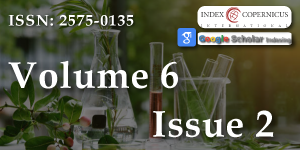Plant molluscicide based on Smolevka white (Silene Latifolia) as prevention of pastoral helminthiasis of animals
Main Article Content
Abstract
Soft-bodied is the intermediate host of helminthiases, in the body of which several development stages of larval forms of helminths occur. There is the highest population density of mollusks in the areas of ruminant grazing, which leads to mass infection of animals with trematodes. To destroy the intermediate host of helminths in agricultural production, molluscicidal remedies of synthetic and plant origin are used. The work aimed to determine the molluscicidal effectiveness of a plant remedy based on Silene Latifolia in conditions of natural pastures. The material for work was the green mass of the plant S. Latifolia obtained in the warm season from roots, leaves, stems, flowers, and seeds. By grinding this plant, a powder with a particle size of 1-3 mm was obtained. Then, the powder was extracted with ethyl alcohol. The obtained product (concentrate) was an amorphous gel-like mass of dark green color with a specific smell and well soluble in water. Fieldwork in natural pastures was carried out on 5 biotopes with an area of 4-25 m2. Three species of gastropods were recorded from freshwater mollusks in the biotopes: Planorbis planorbis, Planorbarius corneus, Physa fontinalis, Lymnaea truncatula, and L. palustris. The results of experiments conducted in the conditions of pastures indicate a high molluscicidal activity of the studied plant agent on pond fish, intermediate hosts of trematodes pathogens. The effectiveness of the developed molluscicide on gastropods, when treated with a working solution (10.0 g/l) is from 98.1 to 100%.
Article Details
Copyright (c) 2022 Postevoy AN, et al.

This work is licensed under a Creative Commons Attribution 4.0 International License.
The Journal of Plant Science and Phytopathology is committed in making it easier for people to share and build upon the work of others while maintaining consistency with the rules of copyright. In order to use the Open Access paradigm to the maximum extent in true terms as free of charge online access along with usage right, we grant usage rights through the use of specific Creative Commons license.
License: Copyright © 2017 - 2025 |  Open Access by Journal of Plant Science and Phytopathology is licensed under a Creative Commons Attribution 4.0 International License. Based on a work at Heighten Science Publications Inc.
Open Access by Journal of Plant Science and Phytopathology is licensed under a Creative Commons Attribution 4.0 International License. Based on a work at Heighten Science Publications Inc.
With this license, the authors are allowed that after publishing with the journal, they can share their research by posting a free draft copy of their article to any repository or website.
Compliance 'CC BY' license helps in:
| Permission to read and download | ✓ |
| Permission to display in a repository | ✓ |
| Permission to translate | ✓ |
| Commercial uses of manuscript | ✓ |
'CC' stands for Creative Commons license. 'BY' symbolizes that users have provided attribution to the creator that the published manuscripts can be used or shared. This license allows for redistribution, commercial and non-commercial, as long as it is passed along unchanged and in whole, with credit to the author.
Please take in notification that Creative Commons user licenses are non-revocable. We recommend authors to check if their funding body requires a specific license.
Peshkova GI, Schreter AI. Plants in home cosmetics and dermatology. Directory. Moscow, St. Petersburg. 2001; 684.
Barabanov EI. Botany: textbook for students of higher educational institutions. Moscow: Publishing Center "Academy". 2006; 448.
Lomanovich AF, Ryabinovich Ayu. Saponins as detergents. - Moscow, Leningrad: Food and food publishing house. 1936; 66.
Larin IV, Agababyan ShM, Rabotisa TA. Feed plants of hayfields and pastures of the USSR. Moscow, Leningrad: State Publishing House of Agricultural Literature. T. III. 1956.
Kovalev VN, Popova NV and Kislichenko VS. Workshop on Pharmacognosy: Textbook for university students. Kharkov: Publishing House National Pharmacological University; Gold pages. 2003; 512.
Varlich VK. Complete illustrated encyclopedia of medicinal plants of Russia. -Moscow. RIPOL Classic. 669.
Alefirov AN. Colon cancer (colon cancer, rectal cancer). Herbal features. Part 1. Lecture number 10. (Electronic resource). 2007.
Phytotherapy in oncology: treatment of colon cancer [Electronic resource].
Vavilov PP, Balyshev LN. Field crops of the USSR. Moscow: Kolos. 1984; 160.
Akmanaev ED. Workshop on fodder production: Section "Meadow fodder production": training manual. Perm: Perm State Agricultural Academy. 2005; 246.
Mayevsky PF. Flora of the middle strip of the European part of Russia (10th edition amended and supplemented). Moscow: Partnership of scientific publications. 2006; 600.
Postevoy AN, Gorokhov VV, Andreyanov ON, Puzanova EV. Guidelines: a modified method of keeping the mollusks Lymnae truncatula to obtain adolescarias of the fascioliasis pathogen Fasciola hepatica. Moscow. All-Russian Research Institute of Parasitology. 2017; 25.
Gorokhov VV, Osetrov VS. Molluscicides and Their Use in Agriculture. Moscow: Kolos. 1987; 224.
Gorokhov VV, Andreyanov ON, Postovoy ON, Danilenko AV. Molluscicide remedy against the pathogens of helminthiasis and a method for obtaining it Patent RU № 2637856 34. 2017.
Lim RR, Rink KJ, Hass HJ and Soage-Echague E. A method for the walecation of cumulation and subchronic median effective. Archives Internationales de Pharmacodynamie et de Thérapie. 1961; 130:335-353.
Khabrieva RU. Manual on the Experimental (Preclinical) Study of New Pharmacological Substances (Moscow: Medicine). 2005; 832.
GOST, 12.1.007-76. (State general standard requirements, 1976) Occupational safety standards system. Noxious substances. Classification and general safety requirements. 1976; 7.
European Convention for the Protection of Vertebrate Animals used for Experimental and Other Scientific Purposes. ETS No.123 (Strasbourg, 18/03/1986).
Gorchakov VV, Gorchakova NV, Izotova ZP. A vegetable remedy for combating freshwater mollusks. Patent RU № 2239321 (Moscow: Rospatent). 2004.
Gorchakov VV Herbal molluscicide made of common tormentil (Potentilla Erecta (L.) Raensch). Bulletin of Altai State Agrarian University. 2016. 9: 147-152.
Gorchakov VV. Remedies of pasture prevention of fascioles. Agricultural Science Euro-North-East. 2007; 10:80-84.
Gorchakov VV. Molluscicide properties of Quercus robur. Agricultural Science Euro-North-East. 2017; 6(61): 55-58.

